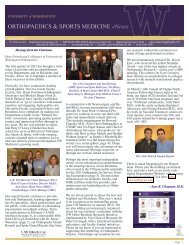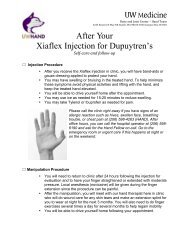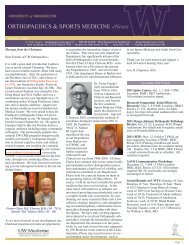2002 - University of Washington Bone and Joint Sources
2002 - University of Washington Bone and Joint Sources
2002 - University of Washington Bone and Joint Sources
You also want an ePaper? Increase the reach of your titles
YUMPU automatically turns print PDFs into web optimized ePapers that Google loves.
Moving Toward Knowledge Building Communities in Health<br />
Information Website Design<br />
TRACEY WAGNER, JENNIFER TURNS, KRISTEN SHUYLER, AND AARON LOUIE<br />
The Arthritis Source is a webbased<br />
information resource<br />
created to help self-motivated,<br />
geographically dispersed learners gain<br />
access to information about arthritis<br />
(www.orthop.washington.edu/<br />
arthritis). It was developed to support<br />
the needs <strong>of</strong> everyone who interacts<br />
with it: the users, the site managers, <strong>and</strong><br />
the content creators. For the past two<br />
years, the Program for Educational<br />
Transformation Through Technology<br />
(PETTT) <strong>and</strong> the UW Department <strong>of</strong><br />
Orthopaedics <strong>and</strong> Sports Medicine<br />
have used a science <strong>of</strong> learning<br />
framework to develop an analysis<br />
process <strong>and</strong> content creation system<br />
that meets the needs <strong>of</strong> both learners<br />
<strong>and</strong> teachers using the Arthritis Source.<br />
Our redesign <strong>of</strong> the Arthritis Source<br />
has been guided by both the current<br />
research on medical information<br />
websites <strong>and</strong> by our own specific<br />
concerns. A variety <strong>of</strong> current studies<br />
on the roles <strong>and</strong> effectiveness <strong>of</strong> medical<br />
websites have discussed some common<br />
shortcomings <strong>and</strong> related design<br />
decisions (e.g., Berl<strong>and</strong> et al., 2001). In<br />
our research, we have moved away from<br />
describing the community <strong>of</strong> users <strong>and</strong><br />
toward focusing on the users’ current<br />
knowledge <strong>and</strong> their goals in visiting<br />
the site. In this work we have attempted<br />
to address some <strong>of</strong> the known problems<br />
<strong>and</strong> also create a systematic solution to<br />
issues <strong>of</strong> content maintenance <strong>and</strong> site<br />
development that meets users’<br />
changing needs. We are attempting to<br />
support the subject matter experts in<br />
creating content that is appropriate for<br />
the users. Most importantly, we wanted<br />
to help patients find answers to<br />
questions concerning their conditions.<br />
We are working on a system <strong>of</strong> site<br />
architecture <strong>and</strong> content development<br />
that can be driven explicitly by both our<br />
underst<strong>and</strong>ing <strong>of</strong> users’ information<br />
needs <strong>and</strong> by users’ interactions with<br />
the site over time. As people use the site,<br />
they will collaborate with the content<br />
authors to create an information<br />
resource that serves users’ purposes <strong>and</strong><br />
will change with their needs.<br />
This redesign transforms the<br />
Arthritis Source from its original state<br />
as a static, encyclopedic object into a<br />
community <strong>of</strong> inquiry <strong>and</strong> practice in<br />
which users learn from each other’s<br />
questions <strong>and</strong> shape the growth <strong>of</strong> the<br />
knowledge base. In this effort, the<br />
designers, content authors, <strong>and</strong> users <strong>of</strong><br />
the website each learn from the others.<br />
Redesigning to support knowledge<br />
building<br />
The Arthritis Source has been a<br />
successful website since its inception<br />
about 1995. It was getting thous<strong>and</strong>s<br />
<strong>of</strong> hits per day <strong>and</strong> users were<br />
submitting unsolicited compliments<br />
through emails. The site covered<br />
Figure 1: Research <strong>and</strong> design work on the Arthritis Source has included many elements. The timeline<br />
above shows an approximate timeline <strong>of</strong> the work done on the site to date.<br />
approximately 100 topics related to<br />
arthritis <strong>and</strong> incorporated a variety <strong>of</strong><br />
media.<br />
Despite this success, we knew we<br />
wanted to make changes to the Arthritis<br />
Source – to update the information, to<br />
address the types <strong>of</strong> concerns emerging<br />
from studies <strong>of</strong> such informational<br />
websites, <strong>and</strong> to make the information<br />
more learner-centered. To address<br />
these issues, we wanted a solution that<br />
would be scalable (so we can continue<br />
to exp<strong>and</strong> the website) <strong>and</strong> enhancable<br />
(so we can make changes with<br />
reasonable levels <strong>of</strong> effort). We also<br />
recognized quickly that the information<br />
designers, content authors, <strong>and</strong> users<br />
needed to come together to collaborate<br />
on the most effective site.<br />
In making our changes, we have<br />
adopted a knowledge building<br />
community perspective. In such a<br />
community, a variety <strong>of</strong> people<br />
contribute to the accumulation <strong>of</strong><br />
knowledge, different people can<br />
contribute in different ways, the<br />
knowledge base builds up over time,<br />
<strong>and</strong> there are st<strong>and</strong>ards <strong>of</strong> quality for<br />
what belongs in the knowledge base.<br />
The members <strong>of</strong> the community learn<br />
from each other by being exposed to<br />
both the products <strong>and</strong> processes <strong>of</strong> the<br />
knowledge creation activities, which<br />
benefits them all. We are using this<br />
perspective as a way <strong>of</strong> thinking about<br />
how the users <strong>of</strong> the Arthritis Source will<br />
interact with the site, with the content<br />
authors, with the designers, <strong>and</strong> with<br />
each other.<br />
Diverse learners, but shared needs<br />
Our earliest work with the Arthritis<br />
Source consisted <strong>of</strong> various efforts to<br />
“know thy learner” so that we could<br />
create a site that was more learnercentered<br />
(Turns <strong>and</strong> Wagner, <strong>2002</strong>). We<br />
used a variety <strong>of</strong> methods to learn who<br />
was visiting the website <strong>and</strong> what they<br />
were doing during their visits. One <strong>of</strong><br />
our most comprehensive activities has<br />
been our use <strong>of</strong> an online survey in<br />
which users <strong>of</strong> the site provide us with<br />
information about themselves <strong>and</strong> their<br />
visit (Turns <strong>and</strong> Liu, 2000). Based on<br />
survey results, personal interviews, <strong>and</strong><br />
emailed comments, we know that our<br />
50 <strong>2002</strong> ORTHOPAEDIC RESEARCH REPORT















